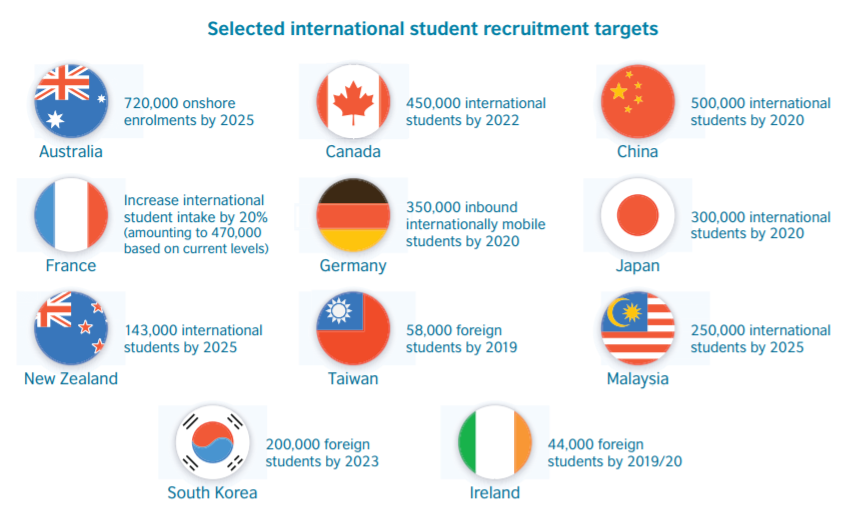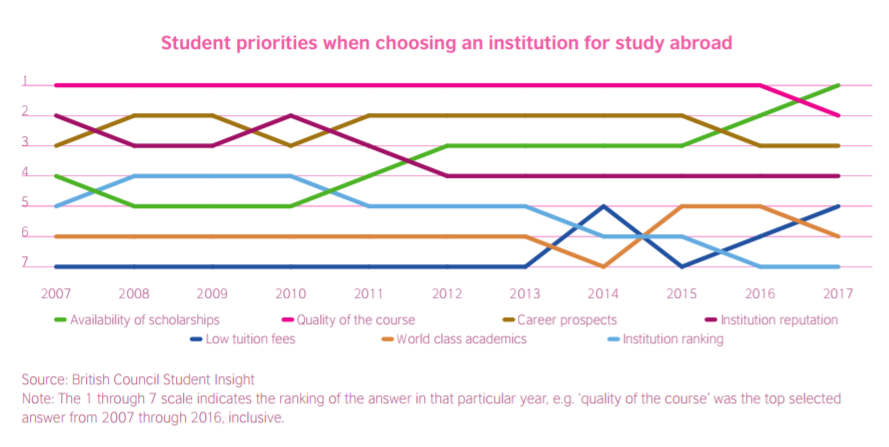10 trends changing global higher education

In June 2017, the British Council released a report illuminating 10 trends in global higher education that impact the future of internationalisation. While the report is written from a UK perspective, the findings can be applied widely. As practitioners in the field, it’s important to keep our finger on the pulse as to what and how global phenomena shape the evolving nature of international higher education. The report focuses on shifting demographics, national strategies for higher education and labour market demands as just a few of the issues impacting the internationalisation of higher education. This post takes a look at the full report.
1. Shifting global demographics
Around the globe as life expectancy rises, the fertility rate decreases. The combination of these two factors leads to a decline in the youth population (aged 15-24 years old). The British Council projects that Africa is the only region where the youth population will continue to grow until 2025. “While demographics are only a small determinant of higher education mobility and enrolment, such stark trends are incontrovertible evidence of opportunities for engagement with students and youth in Africa.”
2. Expansion of education for all
Education around the world continues to develop and expand access. While primary education access continues to increase, there are still issues with completion rates, gender and class disparity. The United Nations Sustainable Development Goals adopted in 2015 strongly advocates for widening access to education by 2030, as articulated in #4 of the 17 global goals.
3. National internationalisation strategies
It’s trendy for national governments to design strategies that include or focus on the internationalisation of higher education. Many times, the rationales for these country-level internationalisation strategies include national prosperity with links to trade and economic growth as well as the recruitment of skilled migration for labor shortages. While the strategies take various form according to the national context, one common aspect is the aim of an international student recruitment target.

Source: British Council
4. Distribution of national funding
National funding for higher education continues to change as internal sectors compete for money and politics play a role in the investment of governmental funds. Decreased funding for higher education may impact national-level scholarship schemes for higher education mobility.
5. Multi-sector cooperation
As employers’ experience challenges in hiring higher education graduates with workforce-ready skills, there is a push for more cooperation between industry and higher education. Through initiatives and partnerships, creative collaborations develop. These types of cooperation are also taking shape in the field of international higher education, for example in virtual international internships.
6. Educational technology
There are two main ways that this report focuses on the importance of educational technology; first online learning and second the impact on teaching, learning and administration. As technology continues to integrate and change the world we live and operate in, higher education must also change with the times and integrate educational technology that facilitates international higher education. This, however, can be a daunting task with the plethora and diversity of educational technologies available. Every year New Media Consortium and EDUCAUSE releases the Horizon Report that focuses in on the future of technology in higher education, which is a nice starting point.
7. Demand for specific skills
With the future of automation, it’s expected that the workplace will undergo a dramatic transformation bringing with it the need for specific workplace-ready skills. Higher education institutions will need to stay in front of these changes to ensure that graduates attain appropriate workplace-ready and transferable skills.
8. Brand and value
When seeking an institution for study abroad, students are considering more aspects than just the brand, ranking and reputation of an institution. The British Council report claims that the quality and value (including costs, career prospects, and student experience) of an institution have increasingly become important in the student choice process.

9. Impact of English
Many consider English as the lingua franca. English as a medium of instruction is a prevalent way to offer international higher education as it continues to attract international students. For example, English-taught degree programmes continue to develop in countries such as Finland and the Netherlands. With this multilingual environment comes challenges and responsibilities. At the same time, the continued prominence of English is uncertain. Will the future bring with it a new lingua franca or will English continue to play an important role in international higher education?
10. Focus on the student experience
International students seek out high quality student experiences, everything from feeling welcome on campus to accessible and valuable career services to student accommodations. Higher education institutions will continue to focus on creating and nurturing quality student experiences with the aim of retaining international students.
The future of international higher education will continue to be shaped and changed by global phenomena. Everything from the demographics to global economy to lingua franca to geopolitics. With evolution, comes opportunities and challenges. Keeping track of global higher education trends allows you to be one step ahead and plan accordingly.
Leasa Weimer is Knowledge Development Adviser at the EAIE.






